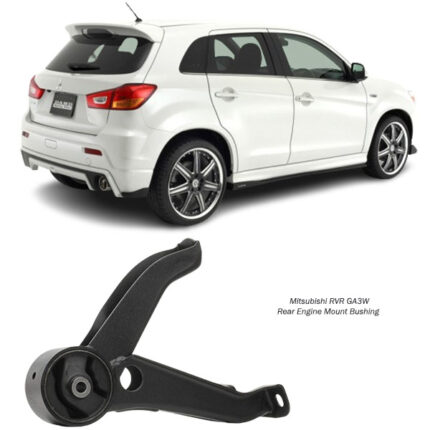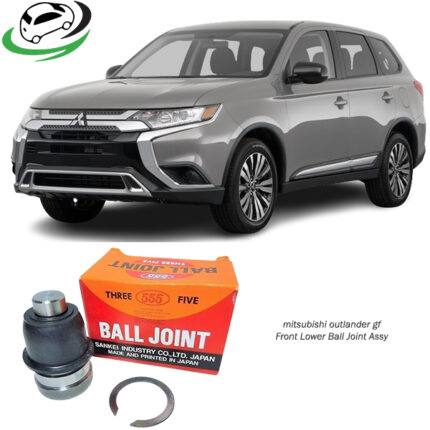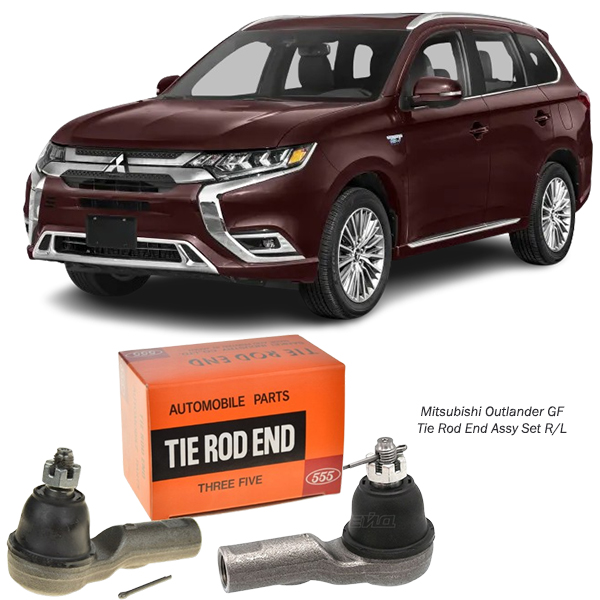-9%
Get Mitsubishi Outlander GF Tie Rod End Assy Set SE-B011 in Kenya
A tie rod end assembly set is a critical part of a vehicle’s steering and suspension system, responsible for connecting the steering rack to the wheels and enabling precise control over vehicle direction. This component directly affects steering response, stability, and overall driving safety. Let’s take a comprehensive look at the tie rod end assembly set, including its purpose, components, types, signs of wear, causes of failure, maintenance, and replacement procedures.
1. Purpose and Function of the Tie Rod End Assembly Set
The tie rod end assembly set serves as a key link between the steering system and the wheels. Its primary purpose is to transfer the force from the steering gear (steering rack) to the wheels, allowing for directional control of the vehicle. Key functions of the tie rod end assembly set include:
- Steering Control: The tie rod ends are essential for translating the steering wheel’s input into movement in the wheels, enabling the driver to control the vehicle’s direction.
- Stabilizing Suspension: Tie rods help maintain proper alignment and positioning of the wheels relative to the suspension. They work together with other suspension parts to keep the wheels stable on uneven road surfaces.
- Supporting Wheel Alignment: Properly functioning tie rod ends keep the wheels aligned and prevent issues like tire wear, pulling to one side, and poor handling.
- Absorbing Minor Road Bumps: The jointed design of tie rod ends allows them to absorb some impact from road irregularities, enhancing ride comfort.
Without a functioning tie rod end, the vehicle’s ability to steer accurately and stay aligned would be compromised, posing a significant safety risk.
2. Components of a Tie Rod End Assembly Set
A standard tie rod end assembly set includes several components, each contributing to its function:
- Tie Rod: The rod itself is a sturdy metal shaft that connects the steering rack to the steering knuckle.
- Inner and Outer Tie Rod Ends: The tie rod is divided into two parts: the inner and outer tie rod ends. The inner tie rod connects to the steering rack, while the outer end connects to the steering knuckle. These ends are often threaded to allow adjustment for proper alignment.
- Ball and Socket Joint: Located at the outer tie rod end, this joint allows for a range of motion necessary to accommodate changes in wheel position due to suspension movement and steering adjustments.
- Grease Fittings or Seals: Many tie rod ends have a grease fitting or seal to ensure proper lubrication, reducing friction and wear. Sealed tie rods come pre-lubricated and do not require additional grease.
- Lock Nut: A lock nut secures the tie rod in place after it’s adjusted for wheel alignment. It prevents the tie rod from shifting or loosening over time.
Together, these components work to maintain a secure, responsive, and flexible connection between the steering wheel and the wheels.
3. Types of Tie Rod Ends
There are a few main types of tie rod ends, designed for different steering and suspension setups:
- Rack and Pinion Tie Rod Ends: Common in most modern passenger cars, these tie rod ends connect directly to the rack and pinion steering gear, providing a compact and responsive steering setup.
- Parallelogram Steering Tie Rod Ends: Found in vehicles with parallelogram steering setups, often larger trucks or older vehicles. These have a different design to accommodate the specific steering linkage.
- Sealed vs. Greaseable Tie Rod Ends: Sealed tie rod ends are lubricated for life and require no maintenance, while greaseable tie rod ends need periodic greasing to maintain smooth operation and reduce wear.
The type of tie rod end depends on the vehicle’s design, weight, and steering system.
4. Symptoms of Worn or Failing Tie Rod Ends
As tie rod ends wear out over time, they may start exhibiting symptoms that impact handling and steering performance:
- Steering Wheel Play or Looseness: Excessive play or looseness in the steering wheel can indicate worn tie rod ends, as they are no longer able to hold the wheels in alignment.
- Uneven Tire Wear: When tie rods are damaged, they cause misalignment, leading to uneven tire wear, particularly on the inner or outer edges.
- Vibration in the Steering Wheel: A loose or worn tie rod can cause vibrations that are felt in the steering wheel, especially when driving at higher speeds.
- Clunking or Knocking Noise: A damaged tie rod end can produce a knocking or clunking noise, especially when turning or going over bumps, as the worn joint moves excessively.
- Vehicle Pulling to One Side: Faulty tie rod ends can cause alignment issues, making the car pull to one side while driving straight.
Recognizing these symptoms early on is essential for preventing further damage and ensuring safe driving.
5. Causes of Tie Rod End Wear and Failure
Tie rod ends are subject to considerable stress and wear due to their role in steering and suspension. Common causes of tie rod end failure include:
- Driving on Rough Terrain: Continuous exposure to rough roads, potholes, and uneven surfaces accelerates wear on tie rod ends.
- Contamination: Dirt, moisture, and road salt can penetrate the tie rod end’s seal, leading to corrosion, lubricant degradation, and faster wear.
- Improper Alignment: Misalignment places uneven stress on tie rods, causing them to wear out prematurely.
- Normal Wear and Tear: Like many mechanical parts, tie rod ends gradually wear down over time and will eventually need replacement as part of regular maintenance.
- Overloading: Carrying excessive weight or towing beyond the vehicle’s capacity can strain the tie rod ends, leading to faster wear.
6. Maintenance Tips for Tie Rod Ends
Though many tie rod ends are sealed and require little maintenance, those with grease fittings benefit from regular lubrication. Here are some maintenance tips:
- Regular Inspections: Checking the tie rod ends during routine maintenance or whenever performing an alignment is essential for catching early signs of wear.
- Lubrication: For greaseable tie rod ends, apply fresh grease at recommended intervals to ensure smooth operation.
- Protective Seals: Ensure that the seals are intact to prevent contamination. If the seal is damaged, it can allow dirt and moisture to degrade the tie rod end.
- Alignment Checks: Having your wheels aligned as part of routine maintenance helps reduce unnecessary strain on tie rod ends.
Regular maintenance extends the life of tie rod ends and improves overall vehicle performance.
7. Replacement Process for Tie Rod Ends
Replacing tie rod ends requires mechanical skill and precision, as they are vital to the vehicle’s alignment and steering. Here’s a general outline of the replacement process:
- Lift and Secure the Vehicle: Safely lift and secure the vehicle to access the tie rod ends.
- Remove the Tire and Locate the Tie Rod End: After removing the tire, locate the outer tie rod end connecting the steering knuckle to the steering rack.
- Loosen the Lock Nut: Loosen the lock nut securing the tie rod end to the steering linkage to enable removal.
- Separate the Tie Rod End from the Knuckle: Using a tie rod puller or other suitable tool, disconnect the tie rod end from the steering knuckle.
- Install the New Tie Rod End: Thread the new tie rod end onto the steering linkage and tighten the lock nut.
- Align the Vehicle: After installation, perform a wheel alignment to ensure proper handling and tire wear.
8. Choosing Quality Tie Rod Ends
When replacing tie rod ends, it’s crucial to choose high-quality parts:
- OEM or Aftermarket Quality: Opt for OEM (Original Equipment Manufacturer) or high-quality aftermarket parts that meet or exceed OEM specifications.
- Material Durability: Look for tie rod ends made from durable materials, such as hardened steel, to resist wear and corrosion.
- Warranty and Brand Reputation: Consider parts from reputable brands that offer warranties, indicating a higher level of reliability and customer trust.
9. Cost and Longevity Considerations
The cost of tie rod end replacement varies depending on the vehicle, part quality, and labor rates. On average, tie rod ends can last 50,000 to 100,000 miles, though driving conditions and maintenance practices can impact their lifespan.
10. Conclusion
Tie rod end assemblies are fundamental components in the steering system, translating driver inputs into precise wheel movement. With proper maintenance, quality parts, and prompt replacement when symptoms appear, tie rod ends can provide consistent, reliable performance, ensuring safe and stable handling for the vehicle.
Follow us on Facebook for more parts.



